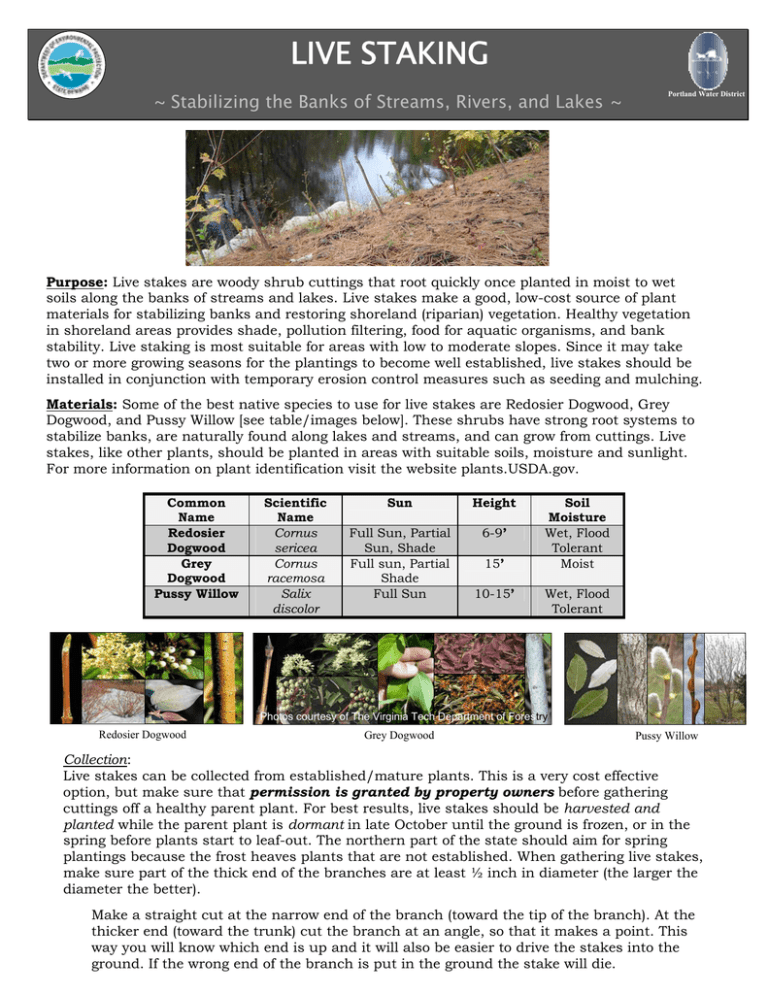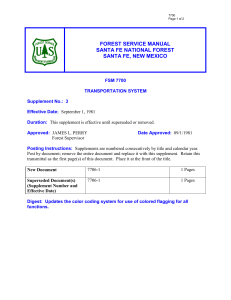~ Stabilizing the Banks of Streams, Rivers, and Lakes
advertisement

LIVE STAKING ~ Stabilizing the Banks of Streams, Rivers, and Lakes ~ Portland Water District Purpose: Live stakes are woody shrub cuttings that root quickly once planted in moist to wet soils along the banks of streams and lakes. Live stakes make a good, low-cost source of plant materials for stabilizing banks and restoring shoreland (riparian) vegetation. Healthy vegetation in shoreland areas provides shade, pollution filtering, food for aquatic organisms, and bank stability. Live staking is most suitable for areas with low to moderate slopes. Since it may take two or more growing seasons for the plantings to become well established, live stakes should be installed in conjunction with temporary erosion control measures such as seeding and mulching. Materials: Some of the best native species to use for live stakes are Redosier Dogwood, Grey Dogwood, and Pussy Willow [see table/images below]. These shrubs have strong root systems to stabilize banks, are naturally found along lakes and streams, and can grow from cuttings. Live stakes, like other plants, should be planted in areas with suitable soils, moisture and sunlight. For more information on plant identification visit the website plants.USDA.gov. Common Name Redosier Dogwood Grey Dogwood Pussy Willow Scientific Name Cornus sericea Cornus racemosa Salix discolor Sun Height Full Sun, Partial Sun, Shade Full sun, Partial Shade Full Sun 6-9’ 15’ 10-15’ Soil Moisture Wet, Flood Tolerant Moist Wet, Flood Tolerant Photos courtesy of The Virginia Tech Department of Forestry Redosier Dogwood Grey Dogwood Pussy Willow Collection: Live stakes can be collected from established/mature plants. This is a very cost effective option, but make sure that permission is granted by property owners before gathering cuttings off a healthy parent plant. For best results, live stakes should be harvested and planted while the parent plant is dormant in late October until the ground is frozen, or in the spring before plants start to leaf-out. The northern part of the state should aim for spring plantings because the frost heaves plants that are not established. When gathering live stakes, make sure part of the thick end of the branches are at least ½ inch in diameter (the larger the diameter the better). Make a straight cut at the narrow end of the branch (toward the tip of the branch). At the thicker end (toward the trunk) cut the branch at an angle, so that it makes a point. This way you will know which end is up and it will also be easier to drive the stakes into the ground. If the wrong end of the branch is put in the ground the stake will die. Live stakes should be between two and three feet long. Once a cut has been made, remove all side branches and leaves. This will help prevent the stakes from drying. Keep these slender side branches, or whips, intact. These whips can be used in the installation process. To increase the survival rate of the stakes, it is best to plant within 24 hours of collection. Until the planting, keep the stakes damp by wrapping them in wet burlap sacks or soaking them in buckets of water. If the stakes are being planted on a hot day, make sure to store them in the shade. Purchase: Local nurseries may carry live stakes. Alternately, call your county Soil and Water Conservation District or Maine DEP for suppliers of live stakes or try an online search. When purchasing live stakes, ensure that the plant species are native to Maine. Installation: The site should be prepared before planting the live stakes. Invasive and competing vegetation should be cut back avoiding the use of herbicides to protect water quality. Information on invasive species can be found at www.mainenaturalareas.org/docs/program_activities. In conjunction with live staking, cover bare soil with erosion control mulch (refer to ECM fact sheet from this series) or annual grasses and hay mulch to hold the soil and help prevent weed establishment until the stakes are established. Stakes should be at a 90° angle 1-3 feet spacing between live stakes ¼ Stake length exposed Push (or use a rubber mallet) to carefully drive the pointed end of each live stake into the stream bank. If the stake doesn’t go into the ground easily, use a metal rod to first create a hole the length of the stake. Stakes should be planted at a 90° angle with ¼ of the stake (including a few buds) sticking out of the ground. When planting, leave 1-3 feet spacing between the individual stakes. ¾ Stake length buried Live Stake length should be 2-3 feet If the stake will be shaded by surrounding vegetation, use longer stakes and leave one foot sticking above the ground. If a willow stake, in particular, gets too much shade, it will drop its new leaves and die. The side branches, or whips, that were snipped off during the collection process will grow nicely if they are planted in very moist areas at the edges of streams and wetlands. Push them into the ground as far as they will go without breaking. Maintenance: If live stakes are planted while dormant, shoots (leaves and small branches) should be seen in spring. If live stakes are planted during the growing season, it may take a full year or two to see results. If two or three growing seasons pass without signs of growth, remove the dead stakes and replace with live stakes. Also, be prepared to replant if the area is affected by high water, drought, or ice damage before the stakes are fully established. To increase survival, the live stakes could be watered once a week during their first growing season. If a bank is severely eroded or steep it will need more stabilization than live staking. Contact your county Soil and Water Conservation District or the Maine DEP for more information and guidance. Part of the Conservation Practices for Homeowners Fact sheet Series, available at: Maine DEP (800.452.1942); http://www.maine.gov/dep/blwq/docwatershed/materials.htm Portland Water District (207.774.5961); http://www.pwd.org/news/publications.php April 2007 DEPLW-0840






